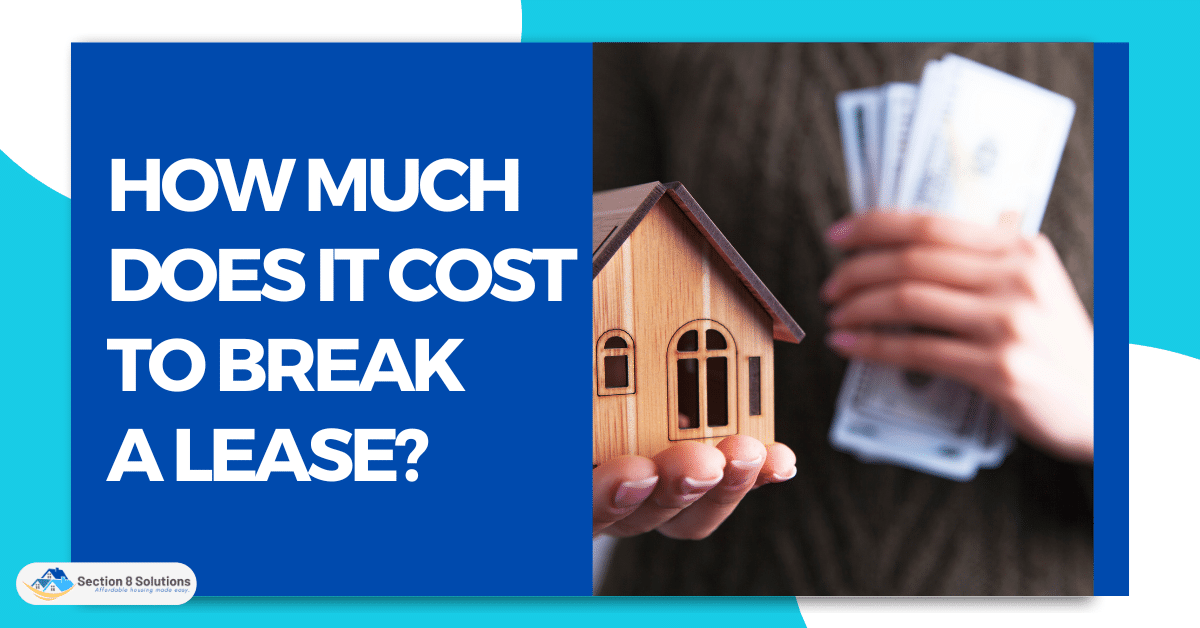Breaking a lease can come with fees, rent until a new tenant is found, and other charges. The cost varies based on factors like the lease agreement, state and local laws, and the reason for termination. Tenants may negotiate or find ways to minimize costs, but understanding the potential expenses is crucial.
In this article, we will explore the costs associated with breaking a lease and what tenants need to know to minimize their financial impact.

Lease Break Fees
Lease break fees are charges that landlords may impose on tenants who terminate their lease before the end of its term. These fees can vary significantly depending on the terms of the lease agreement and state and local laws. Examples of lease break fees may include penalties, administrative fees, advertising costs, or unpaid rent until a new tenant is found.
Lease break fees are often calculated based on the amount of notice given, the remaining lease term, and other factors. For example, a tenant who gives more notice may be charged a lower fee than a tenant who terminates the lease with little notice. Similarly, tenants who break a lease with a longer remaining term may face higher fees than those who break a lease with only a few months left.
In cases of job loss or family emergency, some landlords may eliminate or reduce lease break fees. Tenants should always check the lease agreement and talk to their landlord before breaking the contract.

Rent Until a New Tenant is Found
Regardless of the lease break, landlords may demand tenants to pay rent until a new tenant is found. This means that if a tenant moves due to job loss, a family emergency, or other unanticipated occurrences, they may still be responsible for rent until a new tenant is found. Several states compel landlords to make reasonable efforts to find a new tenant, limiting the current tenant’s rent.
In some cases, landlords can swiftly find a new tenant, easing the financial load on the original tenant. If the rental market is weak or the home needs major renovations, finding a new tenant may take weeks or months. Even if they leave, the original tenant may have to pay rent.
If the tenant has an excellent renting history or is leaving for extenuating circumstances, some landlords may cut or waive rent during a lease break. A landlord may cut rent if the tenant helps find a new tenant or moves out quickly. Tenants should know that landlords are not required to lower or waive rent, and they may have to pay until a new tenant is found.
Tenants should read their lease and comprehend lease break clauses. Lease breaks may contain specific conditions for notice, duration, and rent until a new renter is found. Breaking a lease requires knowledge of state and local legislation.

Advertising Costs
In addition, to rent and lease break fees, tenants who break their lease may also be responsible for advertising costs associated with finding a new tenant. Landlords may charge tenants for the costs of listing the unit on rental websites, hiring a real estate agent, or other marketing expenses. These costs can add up quickly and increase the amount owed by a tenant who breaks their lease.
If a lease is broken, landlords must make reasonable attempts to find a replacement tenant soon. Even if the landlord is looking for a new tenant, tenants may still have to pay rent. The tenant agreed to the lease terms, which oblige them to pay rent until a new tenant is found or the lease expires.
Tenants who are considering breaking their lease should be aware of all the potential costs involved, including advertising costs. They should also review their lease agreement carefully to understand their rights and obligations. In some cases, landlords may be willing to negotiate a reduced amount for advertising costs or waive them altogether if a new tenant is found quickly.

Reletting Fees
Reletting fees are fees that landlords may charge tenants for finding a new tenant to take over the lease. These fees are intended to cover the costs associated with advertising the rental unit, showing the unit to potential tenants, and processing lease applications. Reletting fees vary widely, depending on the landlord and the local rental market. Some landlords may charge a flat fee, while others may charge a percentage of the rent owed for the remaining lease term.
For example, a landlord may charge a flat fee of $500 to find a new tenant, or they may charge a fee equal to one month’s rent. Some landlords may also require the tenant to pay any difference between the previous rent and the new tenant’s rent for the remaining lease term.
It is important to note that not all landlords charge reletting fees, and some may waive the fee in certain circumstances, such as if the tenant has a good rental history or the rental market is strong. Additionally, some states may have laws that limit the amount a landlord can charge for reletting fees.

Legal Fees
In addition to the fees mentioned above, tenants who break their lease may also be responsible for paying legal fees. If a landlord takes legal action against a tenant to recover unpaid rent or other costs associated with breaking the lease, the tenant may be required to cover the landlord’s legal expenses.
Legal fees can vary widely depending on the location and complexity of the case. In some cases, the fees may be relatively low if the dispute is resolved quickly and without much legal involvement. However, in more complex cases, legal fees can quickly add up, leaving the tenant with a significant financial burden.
It’s important for tenants to understand their legal rights and responsibilities when breaking a lease and to seek legal advice if necessary. In some cases, it may be possible to negotiate with the landlord to reduce or waive some of the fees associated with breaking a lease.

Mitigating Costs
Breaking a lease can come with a hefty price tag, but there are ways for tenants to mitigate these costs. Here are some tips and advice for tenants who may need to break their lease for various reasons.
1. Sublease the Unit
Subleasing can be an effective way to mitigate the costs of breaking a lease, as it allows tenants to find someone to take over their lease and cover the remaining rent until the end of the lease agreement. However, it’s crucial to check with the landlord first to ensure subleasing is allowed under the terms of the lease agreement. Some landlords may not allow subleasing, while others may require specific documentation or a written agreement with the subletter.
If subleasing is authorized, a written agreement with the subletter should specify the sublease’s duration, rent, and other conditions. As the subletter will pay rent and maintain the flat, tenants should make sure they are trustworthy.

2. Negotiate With the Landlord
Tenants should negotiate with landlords politely. They should investigate, make a plan, and be flexible. To bolster their argument, tenants should submit documentation of their situation, such as a job loss or medical emergency. Tenants should carefully explain their reasons for breaking the lease and underline their readiness to cooperate and find a solution that works for both sides.
If the landlord agrees to reduce or waive fees, tenants should get the agreement in writing to avoid any misunderstandings in the future. The written agreement should include details such as the reduced or waived fees, the terms of the payment plan (if applicable), and the timeline for finding a new tenant. It’s also a good idea for tenants to familiarize themselves with local tenant laws and regulations before entering into negotiations to ensure they are aware of their rights and protections.
Overall, negotiating with the landlord can be a good option for tenants who need to break their lease but want to minimize the costs involved. It’s important for tenants to approach the conversation respectfully and professionally, and to be willing to compromise and work towards a mutually beneficial solution. If tenants are unsure about their negotiating skills, they may want to consider seeking advice or assistance from a local tenant’s rights organization or legal aid service.

3. Find a Replacement Tenant
Locating a new renter might reduce lease breakage fees. Tenants can find a new leaseholder. First, notify the landlord and make sure the new renter fits all lease conditions. The renter can use rental websites, social media, and friends and relatives to promote the unit. Some landlords help find new tenants.
Be honest about why you’re leaving and the lease terms when seeking a new tenant. The new tenant should know if the previous tenant owes rent or utilities. The original tenant should also give the new renter a signed lease transfer agreement that includes any additional fees or expenditures. Make sure the landlord signs the agreement.
Locating a new tenant can help prevent lease breakage expenses, but it may not always be possible. Tenants should know the dangers, such as the new tenant not paying rent or damaging the property. The original renter may have to pay reletting fees or other expenditures to transfer the lease to a new tenant. Finding a new renter requires communicating with the landlord and understanding the lease agreement.

4. Communicate With the Landlord
Tenants have numerous methods to reduce lease breakage expenses. Subleasing the unit can assist fund rent till the lease expires. Before subletting, tenants should check with the landlord and make sure everything is in writing with the subtenant. Renters should also investigate the subtenant’s credit and background to ensure they meet the lease’s conditions.
Renters can reduce or avoid lease termination fees by negotiating with their landlords. When communicating with landlords, tenants should always act professionally and with respect. Renting needs to have a strategy and be adaptable. They should also explain why they need to break the lease and underline their readiness to cooperate and find a solution that works for both parties. To minimize confusion, tenants should seek a written agreement if the landlord reduces or waives costs.
Ultimately, tenants can find a new leaseholder. Tenants should verify with the landlord before replacing a renter and make sure the new tenant fits all lease terms. Tenants might list the unit on rental websites or social media and show it to prospective tenants. To minimize problems, tenants should make sure the new tenant signs a lease agreement with the landlord and has formal proof of the lease transfer.

Conclusion
Tenants may face lease break fees, rent until a new renter is found, advertising costs, reletting fees, and legal fees. Before ending their lease, residents could discuss expenditures with their landlord to reduce them.
Tips for mitigating these costs include subleasing, negotiating with the landlord, or finding a replacement tenant. Tenants should also be aware of their rights and seek assistance from local tenant’s rights organizations or legal aid services if necessary. Ultimately, careful consideration and communication can help tenants minimize the costs of breaking a lease.












